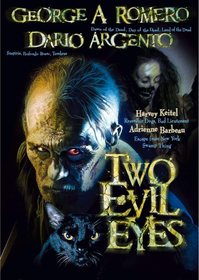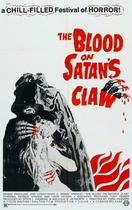Our editor-in-chief Nate Yapp is proud to have contributed to the new book Hidden Horror: A Celebration of 101 Underrated and Overlooked Fright Flicks, edited by Aaron Christensen. Another contributors include Anthony Timpone, B.J. Colangelo, Dave Alexander, Classic-Horror.com's own Robert C. Ring and John W. Bowen. Pick up a copy today from Amazon.com!
Two Evil Eyes (1990)
A retelling of a pair of Edgar Allan Poe stories by two master directors of the horror genre, Two Evil Eyes consists of separate, although thematically related, short films, one by George A. Romero and one by Dario Argento. Either could easily stand on its own.
Both Romero's story choice, "The Case of M. Valdemar," and Argento's, "The Black Cat," were adapted for the silver screen by Roger Corman in his 1962 film, Tales of Terror. Seminal low-budget shocker director Edgar G. Ulmer also lensed an elaborated version of "The Black Cat" in 1934.
Romero's piece is a so-so work in his oeuvre, but Argento's, visuals aside, is as good as anything he's done to date. Both films are interesting in that they reference many other Poe works, from "The Tell-Tale Heart" to "The Pit and The Pendulum." Let's look at them individually:
"The Facts in the Case of M. Valdemar"
Romero's story choice doesn't lend itself as easily to a screen adaptation, so understandably, he embellished Poe's tale of experimenting with "mesmerism" (hypnotism) at the time of death quite a bit. The additions make for a good script, and enable Romero to make a film about greed and karmic retribution (thus making it thematically similar to "The Black Cat"), as well as allowing him to do his zombie thing.
Unfortunately, while the final result is entertaining, it's nowhere near Romero's best work, and plays a bit more like a "made for television" short--something like a good episode of "Tales From the Crypt." The cinematography in this segment is a bit flat, and as a result looks dated far beyond it's actual vintage of 1990.
But the story is intriguing and the small cast is good. Adrienne Barbeau creates much of the tension through the psychological complexities of her character. Ramy Zada, as her secret lover, is just as skilled at making us unsure whether we should trust or distrust him, love him or hate him.
"The Facts in the Case of M. Valdemar" is certainly worthwhile viewing, but hardcore Romero fans may enjoy it less than others, since it's almost impossible to not compare it with his other works, including masterpieces like Dawn of the Dead.
"The Black Cat"
Argento's segment, on the other hand, is a masterpiece itself that ranks right up there with his best works like Suspiria. Although I suppose some Argento fans -- those who like him solely because of his use of unusual visuals, gore and lack of linear plotlines -- may disagree with me here, because "The Black Cat" doesn't strongly contain those stereotypical elements.
Instead Argento gives us taut, thrilling story that plays as much like Hitchcock as anyone else. There are still aspects that make "The Black Cat" unmistakably Argento. For instance, he shrouds Annabel's acquirement of the cat in mystery, and Annabel herself looks fit to the one of Argento's witches. Also, her companion, Roderick Usher (Harvey Keitel, in one of his best performances), is a Weegee-like crime scene photographer. But Dario balances his strong directorial flare with a desire to relay a focused story that is pithy and intense.
"The Black Cat" has some similarities to "The Facts in the Case of M. Valdemar" cinematographically, but it looks less dated, and the style suits the subject matter better.
Argento's take is also more enjoyable in its plethora of Poe references-from the characters' names (and the neighbors are the Pym's) to the means of death that Usher's photographic subjects experience. It evidences more of a sense of humor than most of Argento's films.
Even if you weren't a fan of Romero, Argento or Poe, Evil Eyes is almost a must see. If you are a fan, it may be even more worthwhile, for both the unusual work of the directors and the excellence of their abilities to relay Poe.








